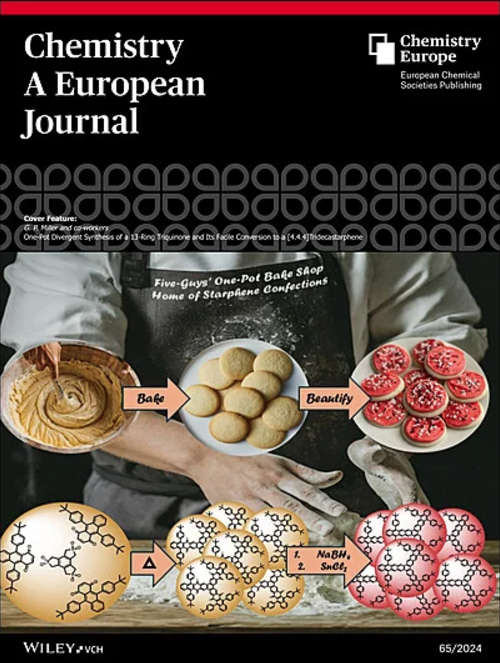n -溴-汉米克中间体。
IF 3.7
2区 化学
Q2 CHEMISTRY, MULTIDISCIPLINARY
引用次数: 0
摘要
我们报道了溴吡啶-2-酰基,n-溴-汉米克中间体,分离在固体氖在4.4 K的表征。计算(B2PLYP, NEVPT2),红外光谱和紫外/可见光谱表征该中间体为具有空σ*型前沿轨道的单线态碳烷。这种不寻常的电子结构(σ2σ*0)允许卡宾通过平面过渡态异构成更稳定的吡啶互变异构体,避免了其他单线态卡宾的平面性偏离。在实验的低温下,这种化合物与氢分子的反应面临着一个很小但令人望而却步的障碍(8.4千卡摩尔-1)。本文章由计算机程序翻译,如有差异,请以英文原文为准。
The N-Bromo-Hammick Intermediate.
We report the characterization of bromopyridin-2-ylidene, the N-bromo-Hammick intermediate, isolated in solid neon at 4.4 K. Computations (B2PLYP, NEVPT2), IR, and UV/vis spectroscopy characterize this intermediate as a singlet carbene with a vacant σ*-type frontier orbital. This unusual electronic structure (σ2σ*0) allows the carbene to isomerize to its more stable pyridine tautomer via a planar transition state, avoiding the deviation from planarity seen in other singlet carbenes. The compound's reaction with molecular hydrogen faces a minor but prohibitive barrier (8.4 kcal mol-1) at the low temperatures of the experiment.
求助全文
通过发布文献求助,成功后即可免费获取论文全文。
去求助
来源期刊

Chemistry - A European Journal
化学-化学综合
CiteScore
7.90
自引率
4.70%
发文量
1808
审稿时长
1.8 months
期刊介绍:
Chemistry—A European Journal is a truly international journal with top quality contributions (2018 ISI Impact Factor: 5.16). It publishes a wide range of outstanding Reviews, Minireviews, Concepts, Full Papers, and Communications from all areas of chemistry and related fields.
Based in Europe Chemistry—A European Journal provides an excellent platform for increasing the visibility of European chemistry as well as for featuring the best research from authors from around the world.
All manuscripts are peer-reviewed, and electronic processing ensures accurate reproduction of text and data, plus short publication times.
The Concepts section provides nonspecialist readers with a useful conceptual guide to unfamiliar areas and experts with new angles on familiar problems.
Chemistry—A European Journal is published on behalf of ChemPubSoc Europe, a group of 16 national chemical societies from within Europe, and supported by the Asian Chemical Editorial Societies. The ChemPubSoc Europe family comprises: Angewandte Chemie, Chemistry—A European Journal, European Journal of Organic Chemistry, European Journal of Inorganic Chemistry, ChemPhysChem, ChemBioChem, ChemMedChem, ChemCatChem, ChemSusChem, ChemPlusChem, ChemElectroChem, and ChemistryOpen.
 求助内容:
求助内容: 应助结果提醒方式:
应助结果提醒方式:


